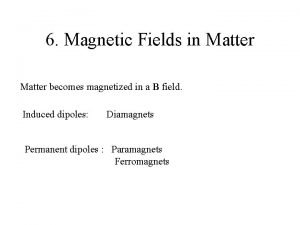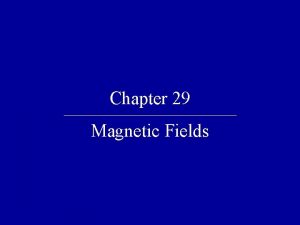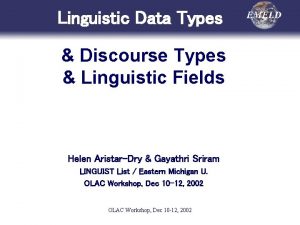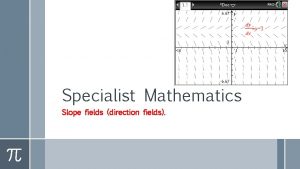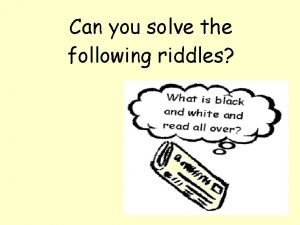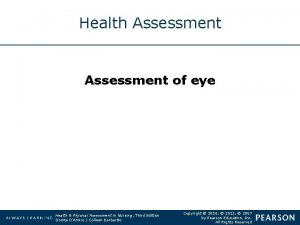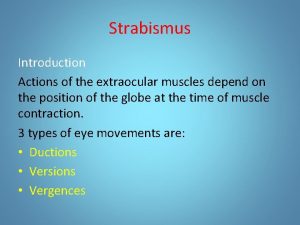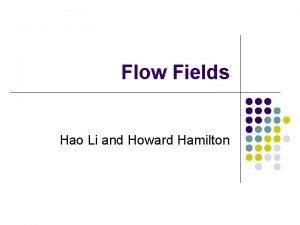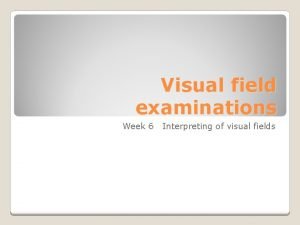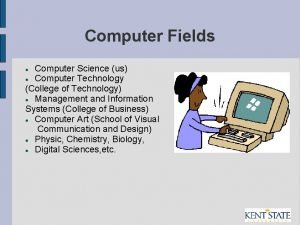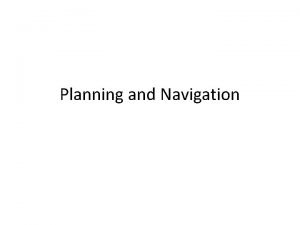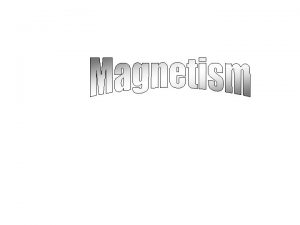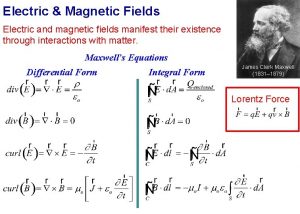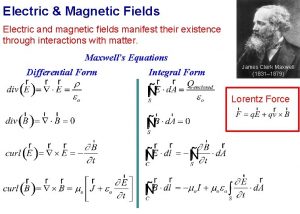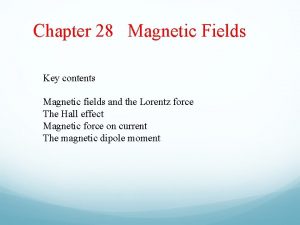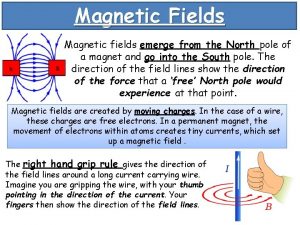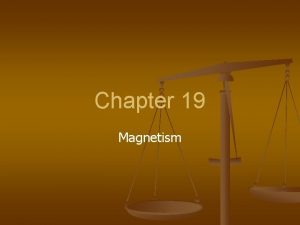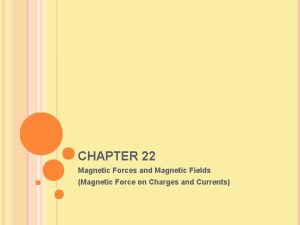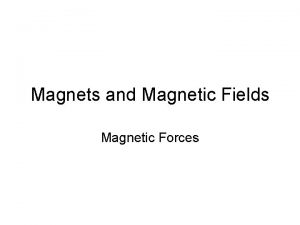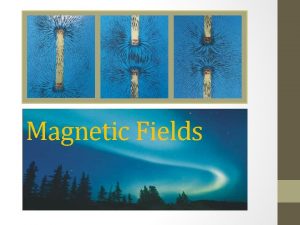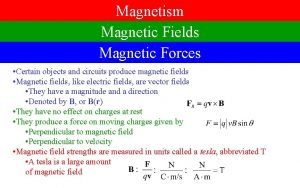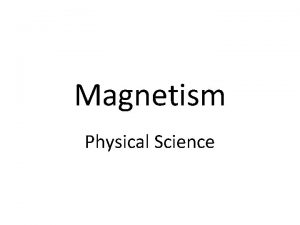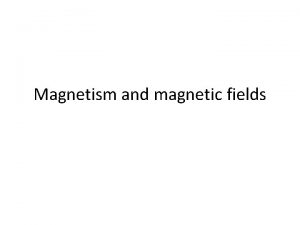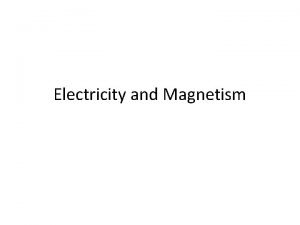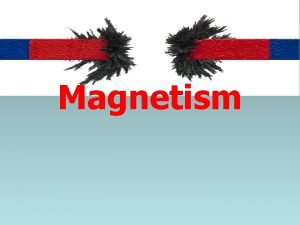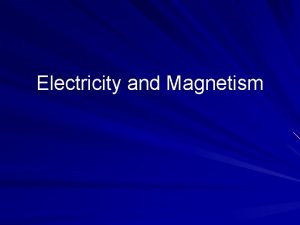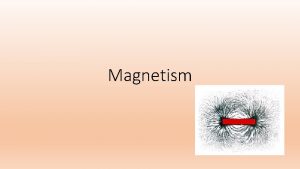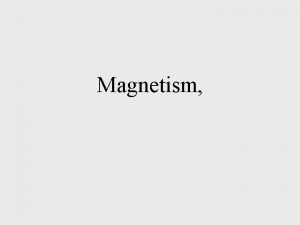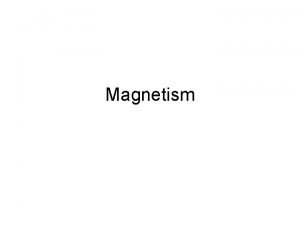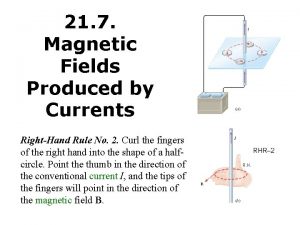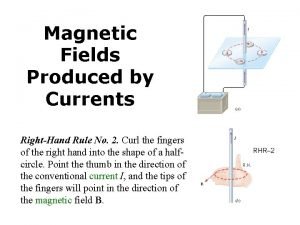Magnetism magnetism 1 magnetism Magnetic fields are produced



































- Slides: 35

Magnetism magnetism 1

magnetism Magnetic fields are produced by moving electrical charges – i. e. , currents) Ø macroscopic (e. g. currents in a wire) Ø microscopic (electrons in atomic orbit and rotating around their own axis) magnetism 2

magnets Ø the magnetic field produced by electrons tend to cancel each other, so most materials are not magnetic Ø in certain ‘ferromagnetic’ materials (iron) neighboring electrons can couple and form domains (< 1 mm) that are magnetic. Since there are many domains that have different orientation, the material is overall not magnetized Ø when an external magnetic field is applied the fields in the different domains align and the whole object becomes magnetic Ø after the external field is removed, a material like iron becomes unmagnetized quickly, but some remain magnetized and can be used as ‘permanent’ magnets. magnetism 3

para and ferro magnets strawberry in a B-field do not retain any magnetism in absence of external field retains domains in which magnetic field remain in the absence of external fields magnetism 4

magnetic poles and fields Ø magnets have ‘north’ and ‘south’ poles and field lines point in the direction of force on a North magnetic pole. Ø unlike the case of electrical fields, where positive charges can exists separate from negative charges, north and south poles always come together. There are no monopoles discovered so far. demo: magnetic field lines (ohp) broken magnetism 5

One big magnet! demo: compass needles compass Why is it higher here? Note that the geographical North pole is in fact the magnetic south pole B=0. 3 -0. 6 x 10 -4 Tesla magnetism 6

question If you are standing exactly at the (magnetic) south Pole (I. e. near the geographical north pole), and are holding a compass parallel with the earth’s surface, in which direction would the needle point? a) It would point roughly to the geographical south b) It could point anywhere c) It would rotate with constant angular speed The compass needle in fact wants to point into the earth (along the direction of the field line). But if hold parallel to earth, it can’t do that and will point wherever. There is no reason for it to rotate though. magnetism 7

charged particles moving in a magnetic field Ø A charged particle q that is moving with a velocity v in a magnetic field B will feel a force where q: charge of particle v: velocity of paticle B: magnetic field : angle between velocity vector and field direction magnetism 8

direction of force on charged paricles in B-field demo: bending the beam I Ø magnitude of the force Ø you can find the direction of the force using the right hand rule. It holds for positive charges. For negative charges switch the direction of the force In the 3 pm lecture (Section 2), we will use the version of Right Hand Rules given in the Textbook. magnetism 9

example: electron in magnetic field Ø an electron with v=1 x 106 m/s is entering a area with B=1 T. The field is directed into the screen. a) in which direction will the electron be bent, if at all? b) how large is the force? what is the acceleration? x x x x a) use right hand rule: x x x thumb is velocity (initially to the right) index finger is field (in the screen) middle finger is force perpendicular to both switch direction because negative charge b) F=|q|v. Bsin =1. 6 x 10 -19 x 1 x 106 x 1=1. 6 x 10 -13 N a=F/m=1. 6 x 10 -13 N/9. 11 x 10 -31 kg =1. 76 x 1017 m/s 2 magnetism x 10

question Ø A Magnesium ion (Z=12) with all its electrons removed is moving in a field of 0. 1 T as shown. What direction will the force act? a) into the screen b) out of the screen c) parallel to the B field lines and the screen d) perpendicular to the B field lines and parallel to the screen e) in the direction of motion magnetism Mg 45 o v 11

Charged particle in a magnetic field Ø Let’s assume a charged particle is moving in a uniform magnetic field so that the velocity is perpendicular to the field. Ø The particle will follow a curved path and is directed towards the center Ø Use Newton’s second law and the equation for centripetal acceleration demo: bending the beam II magnetism 12

Magnetic spectrometers Beam from cyclotrons target chamber S 800 spectrometer At the cyclotron Bending angle ~ 150 o magnetism 13

question In a nuclear reaction two types of fully ionized particles are created. 120 Sn with Z=50 and v=12. 8814 x 107 m/s (Tin) 120 Sb with Z=51 and v=13. 099 x 107 m/s (Antimony) Both have a mass of 1. 991 x 10 -25 kg and pass through a 180 o magnetic spectrometer with B=1 T. If the detector used to locate the particles can separate events that are 2 mm away from each other, are 120 Sn and 120 Sb separated? r= mv/q. B For 120 Sn: M=1. 991 x 10 -25 kg v=12. 8814 x 107 m/s B=1 T q=50 x 1. 6 x 10 -19 C. RSn=3. 2060 m For 120 Snb: M=1. 991 x 10 -25 kg v=13. 0990 x 107 m/s B=1 T q=51 x 1. 6 x 10 -19 C. RSb=3. 1961 m RSn-RSb=3. 206 -3. 1961=9. 9 x 10 -3 m = 9. 9 mm thus separated magnetism 14

What we did so far Ø Moving charged particles make magnetic field Ø North and South poles cannot exist independently Ø The magnitude of a force on a charge particle in a magnetic field: F=qv. Bsin where is the angle between v and B. Ø The direction of the force is given by the (first) right -hand rule Ø for + particles: use directly Ø for – particles: after using the right hand-rule, reverse the direction of the force Ø For a particle moving in a direction perpendicular to a magnetic field magnetism 15

Question Ø a proton is moving from left to right into a field of which the field lines point into the screen. As a result, the proton will a) continue along its original trajectory b) bend upwards c) bend downwards d) bend into the screen e) bend out of the screen proton magnetism x x x 16

magnetic force on a conducting wire Ø consider positive charges moving through a wire. Each particle feels a force, hence there is a net force on the wire Ø N: total number of charges Ø n: charges per unit volume Ø Use: see earlier Ø To get I Ø More general: Ø where : angle between I and B vectors magnetism I 17

question: a floating wire Ø a 1 m long copper wire of unknown mass is held horizontally with a current of 1 A going through it. It is placed in a horizontal magnetic field whose field lines are perpendicular to the wire. When the magnetic field is 1 T, one can let go of the wire without if falling down. top view What is its mass? I B electrons are moving left to right, so force due to B is up (out of the screen). When floating Fgravity=FB-field mg=Bil so m=Bil/g=1 x 1 x 1/9. 81=0. 102 kg magnetism 18

question x Ø a rectangular looped copper wire carrying a current is placed horizontally in a B-field pointing down. Disregarding any other forces, it will move a) in direction of vector A b) in direction of vector B c) in direction of vector C d) in direction of vector D e) none of the above magnetism x A x x x B x x x x C x x top view x D x I x x 19

question x x Ø a rectangular looped copper wire x x carrying a current is placed horizontally in a B-field pointing x B x down. Disregarding any other forces, it will move x x Ø a) in direction of vector A Ø b) in direction of vector B x x Ø c) in direction of vector C Ø d) in direction of vector D Ø e) none of the above Ø correct answer: e) A x x C x top view x D x I x x x It will not move at all. Forces on left and right sides will cancel and likewise for top and bottom sides magnetism 20

Torque on a current loop Top view Rotation axis Ø Consider a current loop with dimension a x b in a B-field parallel b I to the loop. B Ø The force F on the right side (length b): F=BIb (pointing into the screen in the top view or downward in the frontal view) a Ø The force F on the left side (length F b): F=BIb (pointing out of the screen in the top view or upward in the x frontal view) Ø force on up/down side (length a) is frontal view F zero Ø With the given rotation axis: If there is a net torque, Torque: =Fd=(BIb x a/2) + (BIb x a/2) =BIba=BIA with A=axb: surface of the loop will rotate! loop. magnetism 21

Torque on a current loop Top view Ø Now the loop makes an angle with the B-field as shown right Ø To calculate the torque we only need the force perpendicular to the rotating loop: FL=Fsin =FLd=(BIb x a/2)sin + (BIb x a/2) sin =BIbasin =BIAsin Ø If there would be N loops: =BIANsin F frontal view FL sin =F/FL magnetism Rotation axis b I B a F frontal view x F 22

So… Ø The general equation for a torque on a loop of N windings of wire is: Ø with Ø B: magnetic field strength Ø I: Current through the loop Ø A: area of the loop (also holds for non-rectangular loops) Ø N: number of windings Ø : angle between B and line perpendicular to loop Ø =IAN magnetic moment of the coil: it is a vector perpendicular to the coil. is also the angle between and B. Note that is independent of B and , so it describes the properties of the coil when placed in a field. Unit: Am 2 B I magnetism A N 23

note for loncapa: area of an ellipse: ab with a, b radii in the two directions example Ø A circular coil of 5 windings is placed in a B-field of 2 T that B o makes and angle =60 with A N I the line perpendicular to the coil. The radius of the coil is 3 cm, and the current through the coil is 0. 5 A. What are: A= r 2= (0. 03)2=2. 82 x 10 -3 m 2 a) the area of the coil? b) the magnetic moment of =IAN=0. 5 the coil? x 2. 82 x 10 -3 x 5=7. 1 x 10 -3 Am 2 c)the torque one the coil? = Bsin = 7. 1 x 10 -3 x 2 T x 0. 866=1. 23 x 10 -2 Nm magnetism 24

electric motor By supplying electricity we can get some work done! magnetism 25

creating magnetic field with current Ø So far, we have seen that magnetic field can affect the motion of charged particles. Ø However, the reverse is also true: moving charge can create magnetic fields. Ø First seen by Hans Oersted who noted that a current through a wire creates a magnetic field. Ø A second right-hand rule can be used to find the direction of the magnetic field demo: Oersted experiment magnetismmagnetic field of a current 26

How to quantify the field Ø 0 = “permeability of free space” = 4 x 10 -7 Tm/A magnetism 27

an electron passing a wire Ø an electron with v=1 x 106 m/s is I=1 A moving parallel to a wire carrying a current I=1 A at a q=-1. 6 x 10 -19 C distance of 2 cm, in the same 2 cm direction as the current a) What is the direction of the nd magnetic field near the electron a) use 2 right hand rule B-field goes into the screen due to the wire? b) b) what is the magnitude of the magnetic field near the electron? c) what is the direction of the force =4 x 10 -7 x 1/(2 0. 02)=1 x 10 -5 T on the electron? c) use 1 st right-hand rule and notice d) what is the magnitude of the that the electron is negative. force on the electron? Force points to the right. d) F=qv. Bsin =1. 6 E-19 x 1 E 6 x 1 E-5 x 1= = 1. 6 E-18 N (note sin(90)=1) magnetism 28

question Ø a proton is passing by a wire carrying current and is moving perpendicular to the wire, into the screen 1) what is the direction of the B-field near the proton? Ø into the screen Ø out of the screen Ø to the left Ø to the right Ø up 2) what is the direction of the force on the proton? Ø to the left Ø to the right Ø up Ø down Ø no force at all magnetism I x proton moving into the screen 1) use 2 nd right hand rule (same as example on previous slide) 2) use 1 st right hand rule. velocity is into the screen, B-field is into the screen: no Force (sin(00)=0) 29

magnetic force between two parallel wires Ø if we place two parallel wires next to each other, the current in wire 2 creates a field near wire 2, at distance d from wire 1: d Ø The force on wire 1 due to wire 2 is then: Ø Note Ø so that the force per unit length is: magnetism attractive if same direction repulsive if opposite direction 30

question Ø two wires are placed parallel, one carrying a current of 1 A and the other of 2 A, in the same direction. The distance between the two wires is 2 cm Ø a) what is the magnitude of the B-field exactly in between the two wires? Ø b) if a proton moves parallel to the two wires with v=1 x 105 m/s, exactly in between the two and in the same direction as the current, what is the magnitude of the force on the proton? Ø c) what is the force per unit length between the two wires? a) B 1= 0 I/(2 r)=4 x 10 -7 x 1/(2 0. 01)=2 x 10 -5 T 1 A -7 -5 B 2= 4 x 10 x 2/(2 0. 01)=4 x 10 T B 1: into the screen B 2: out of the screen Bnet=2 x 10 -5 T out of the screen 1 b) F=qv. Bsin =1. 6 x 10 -19 x 105 x 2 x 10 -5 x sin(90)=3. 2 x 10 -19 N (directed to the right, use 1 st right-hand rule) c) F/l= 0 I 1 I 2/(2 d)= 4 x 10 -7 x 1 x 2/(2 0. 02)=2 x 10 -5 N 2 cm magnetism 2 A 2 31

note Ø the procedure of the previous slide can be used for any number of wires. In case of 4 wires (see lon-capa), one can calculate the force of one on the wires by adding the forces of each of the other three wires on that wire… magnetism 32

other cases: the current loop Ø magnetic field inside a current loop I I R X right-handed current through loop: B-field in the screen left-handed current through loop: B-field out of the screen magnetism Ø example: A person wants to find the current in a superconducting coil with diameter of 2 cm. She measures the magnetic field at the center to be 1 x 10 -5 T. What is the current? I=2 RBcenter/ 0= 2 x 0. 01 x 10 -5/4 x 10 -7= 0. 16 A 33

other cases II: magnetic field of a solenoid Ø a solenoid is a collection of coils stacked on top of each other Ø Inside a perfect solenoid, the field lines are parallel and the field uniform Ø outside the solenoid, the field pattern looks like that of a bar magnet. Ø For the field inside of a solenoid: where I is the current and n is the number of turns (n) per unit length l of the solenoid Ø note that the field at the center does not depend on the radius of the turns B-field of solenoid magnetism 34

example Ø A perfect coil is 30 cm long and has 3000 windings. Its radius is 2 cm. What is the field strength along the central line inside the coil if the current is 4 A? B= 0 n. I=4 x 10 -7 x 3000/0. 3 x 4 = 1 x 10 -3 T use n=N/L Ø The field strength along a line parallel to the central line but 5 mm away from the center is … along the central line? a) lower than b) the same as c) higher than inside the coil, the field is uniform magnetism 35
 Antigentest åre
Antigentest åre Red fields to green fields
Red fields to green fields Visualizing magnetic field
Visualizing magnetic field Magnetic field in matter
Magnetic field in matter Magnetic fields quick
Magnetic fields quick Learning: module 26: magnetic forces and fields
Learning: module 26: magnetic forces and fields Electric currents and magnetic fields
Electric currents and magnetic fields Magnetism lesson outline answer key
Magnetism lesson outline answer key Conceptual physics magnetism
Conceptual physics magnetism Magnetic moment and magnetic field relation
Magnetic moment and magnetic field relation F=i(lxb)
F=i(lxb) Coercivity
Coercivity Flux formula
Flux formula Kali fields
Kali fields Electric forces and fields concept review
Electric forces and fields concept review Fields on wheels
Fields on wheels Into the fields internship
Into the fields internship Linguistic fields
Linguistic fields Slope field ti nspire
Slope field ti nspire Describing fields
Describing fields How many fields in computer science
How many fields in computer science Banana dresser grammar potato revive
Banana dresser grammar potato revive Cecl data fields
Cecl data fields Eye
Eye Eviatar fields
Eviatar fields 6 cardinal fields of gaze
6 cardinal fields of gaze Natural grass athletic fields
Natural grass athletic fields Multiplicative inverse
Multiplicative inverse Howard fields
Howard fields Conceptual physics chapter 33
Conceptual physics chapter 33 Hemianopia
Hemianopia How to read slope fields
How to read slope fields What are the allied fields of physical education
What are the allied fields of physical education How many fields in computer science
How many fields in computer science Tree mao
Tree mao John mccrae in flanders fields
John mccrae in flanders fields



